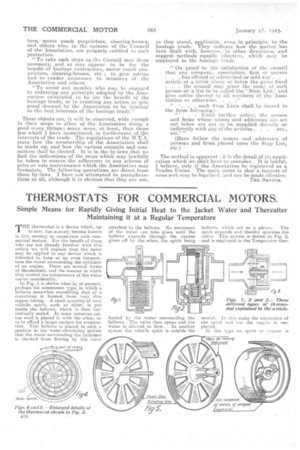THERMOSTATS FOR COMMERCIAL MOTORS.
Page 22

Page 23

If you've noticed an error in this article please click here to report it so we can fix it.
Simple Means for Rapidly Giving Initial Heat to the Jacket Water .and Thereafter Maintaining it at a Regular Temperature THE thermostat is a device which, up to now, has scarcely become known in this country in connection with commercial motors. For the benefit of those who are not already familiar with this article we will explain that the name may be applied to any device which is ir.tended to keep at an even temperature the water surrounding the cylinders of an engine. There are several forms of thermostats, and the manner in which they control the. temperature of the water varies considerably.
in Fig. 1 is shown what. is, at present, perhaps the commonest type, in which a bellows somewhat resembling that of a concertina is formed, from very thin copper tubing. A small quantity of very volatile spirit, such as ether, is put inside the bellows, which is then hermetically sealed. in some instances cotton wool is placed in with the ether, so as to afford a laiger surface for evaporation. This bellows is placed in such a position in the water-circulating system that the water surrounding the cylinders is checked from flowing by the valve attached to the bellows. No movement of the water cart take place until the bellows expands through the vapour given off by the ether, the spirit being heated by the water surrounding the bellows. The valve then opens and the water is allowed to flow. In another system the volatile spirit is outside the bellows, which act as a piston. The spirit expands and thereby operates ..the valve. This system is shown in Fig.. 2, and is employed in the Temporator ther
mostat. In this Make the .expansion of the -spirit. and -rot the vagour is employed.
In this type no spirit, or vapour is employed, all parts being of metal, the uneven expansion of different, s metals being used as a force to operate the valve. Some difficulty has been experienced in hermetically sealing such very volatile spirits as are useful for the operation of the bellows type, as the most minute porosity is sufficient to enable the spirit or its vapour to escape. In the " all-metal " type two strips of metal are united as shown in Figs. 3, 4 and 5; the outer of these is of ru.stless steel, and the inner one ia of an alloy which has a greater expansion for any given temperature than that of steel. The result of a rise in temperature is that the coil tends to straighten out, and, by so doing, imparts a slight rotary motion to the disc against which it lies, so causing its radial slots to coincide with those in the stationary disc and to open the passages and allow the water to flow.
• There are two different arrangements of water circuit in use: Fig. 6 shows the simplest. form, in which the flow of water is merely stopped until the temperature rises to some predetermined, degree, when the valve opens, either entirely or partly, as desired, and allows the water to flow.. In all makes there is some provision for adjusting the temperature at which the valve opens, and, once set, this remains constant.
As centrifugal pumps are almost universal now, there is no need to divert the flow to a short circuit as shown in Fig. 7, unless the water is used for heating the' carburetter, in which case the water call ba diverted by means of a double valve, so that it follows the course indicated by the arrows until the desired temperature is attained.
The first object of the use of a thermostat is to enable an engine to develop its full power within a few minutes of starting from cold. Only the water in the jacket immediately surrounding the cylinder has to be warmed before good working is ebtained. In many vehicles quite am appreciable time is spent in running the engine before good going can be relied upon. This is particularly annoying in the case of a public-service vehicle.
This trouble is avoided by the use of a thermostat, and an even temperature of the cylinders can he assured, which tends to economy in petrol and a reduction in carbon cteposit. The regulation of heat by means of shutters in front of the radiator is, in some cases, operated by means of a bellows, such as that shown in Fig. 1. We are afraid that such means of operating them, however, would be hardly in keeping with the conditions under which commercial motors usually work.
Shutters, although they are of great use in keeping ass engine warm. while standing, are of little use for the purpose for which a thermostatic valve is intended, namely, the quick warming up of the engine when starting from cold. There is one point which we should like to emphasize in connection with the We of thermostatic valves, and that is they in no way reduce the liability of water to freeze in the radiator.






























